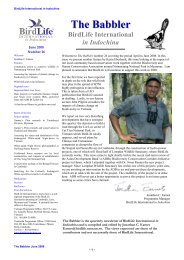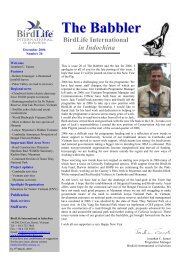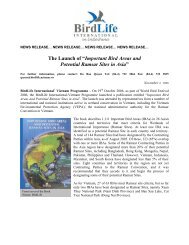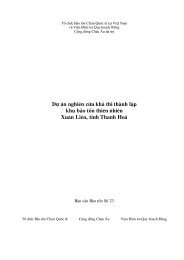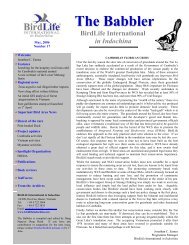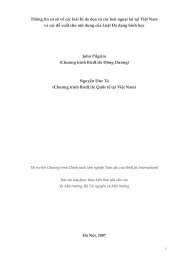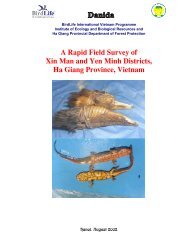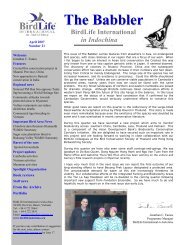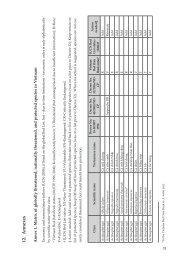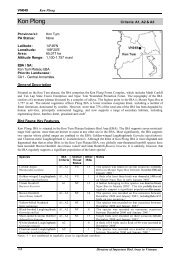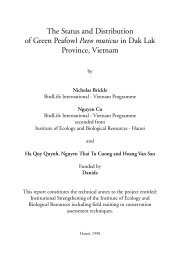Bird Life Tieng Anh-01.qxd - Birdlife International in Indochina
Bird Life Tieng Anh-01.qxd - Birdlife International in Indochina
Bird Life Tieng Anh-01.qxd - Birdlife International in Indochina
Create successful ePaper yourself
Turn your PDF publications into a flip-book with our unique Google optimized e-Paper software.
22<br />
•<br />
Control hunt<strong>in</strong>g by means of appropriate prov<strong>in</strong>cial, district or commune-level regulations,<br />
comb<strong>in</strong>ed with tra<strong>in</strong><strong>in</strong>g and appropriate <strong>in</strong>centives for local communities.<br />
• Incorporate environmental considerations <strong>in</strong>to future aquacultural development plans.<br />
Changes s<strong>in</strong>ce 1996. A survey of 18 coastal wetland sites <strong>in</strong> the Red River Delta by <strong>Bird</strong><strong>Life</strong><br />
<strong>International</strong> and FIPI <strong>in</strong> 1996 identified Nghia Hung as the second most important site for wetland<br />
conservation, and proposed the area be established as a nature reserve. 3 The effects of hunt<strong>in</strong>g, overexploitation<br />
and habitat loss to aquaculture, however, have massively devalued the biodiversity<br />
importance of this site. Today, not one of the seven globally threatened bird species once found at<br />
Nghia Hung now occurs, and just one species (Kentish Plover Charadrius alexandr<strong>in</strong>us) occurs<br />
at a level of more than 1% of the Asian biogeographic population. An estimated 30,000 shorebirds<br />
were present <strong>in</strong> April 1994, but fewer than 1,000 shorebirds were recorded <strong>in</strong> late March 2005<br />
(Nguyen Duc Tu and Le Trong Trai 2005). This has been a sad loss of what only a decade ago<br />
was one of the foremost sites for migrant waterbirds <strong>in</strong> Asia.<br />
5. Site rank<strong>in</strong>g<br />
An attempt has been made to quantify and rank the six Red River Delta sites accord<strong>in</strong>g to their<br />
conservation importance (see Tables 1 and 2).<br />
It is important to appreciate, however, that although waterbirds may concentrate at a few sites, they<br />
utilise the entire coastal zone dur<strong>in</strong>g migration where they are at risk from a variety of threats.<br />
Therefore, it is vital to implement appropriate conservation measures along the entire Red River<br />
Delta coastl<strong>in</strong>e and not just at a handful of key sites <strong>in</strong> order to protect the unique and globally<br />
important avifauna of the region.<br />
Criteria used are expla<strong>in</strong>ed <strong>in</strong> the notes to the scor<strong>in</strong>g system (see Table 2). This rank<strong>in</strong>g gives an<br />
order of relative importance for the six IBAs as follows: Xuan Thuy (first, 44 po<strong>in</strong>ts), Thai Thuy<br />
(25 po<strong>in</strong>ts), Tien Hai (19 po<strong>in</strong>ts), Tien Lang (10 po<strong>in</strong>ts), Nghia Hung (8 po<strong>in</strong>ts) and An Hai (6<br />
po<strong>in</strong>ts).<br />
6. General conclusions and recommendations<br />
The Red River Delta is a vital location for biodiversity conservation <strong>in</strong> Indoch<strong>in</strong>a. It is of paramount<br />
importance for migratory waterbirds visit<strong>in</strong>g and pass<strong>in</strong>g through the region from north-east Asia<br />
and Siberia to Australasia, and there is an <strong>in</strong>ternational obligation to ma<strong>in</strong>ta<strong>in</strong> its <strong>in</strong>tegrity and habitat<br />
quality.<br />
However, a major threat to bird populations throughout the coastal zone of the Red River Delta is<br />
hunt<strong>in</strong>g, frequently <strong>in</strong> the form of mistnett<strong>in</strong>g, often us<strong>in</strong>g taped calls. This technique is <strong>in</strong>discrim<strong>in</strong>ate<br />
and particularly serious dur<strong>in</strong>g migration periods. Hunt<strong>in</strong>g was identified as a potential problem at<br />
all sites, although hunt<strong>in</strong>g is nowadays stirctly controlled with<strong>in</strong> Xuan Thuy National Park and at<br />
Thai Thuy IBA. Also significant is the threat of habitat loss, particularly conversion of mangrove<br />
and mudflats <strong>in</strong>to aquacultural ponds. Better plann<strong>in</strong>g is required at all levels to develop aquaculture<br />
<strong>in</strong> a more susta<strong>in</strong>able manner.<br />
Control of hunt<strong>in</strong>g and better land-use plann<strong>in</strong>g, particularly with respect to aquaculture development,<br />
are therefore the two key conservation issues that need to be addressed <strong>in</strong> the Red River Delta region.<br />
Specific conservation recommendations for each site are given <strong>in</strong> the relevant sections of this report.




